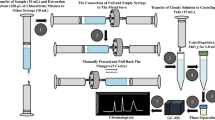Abstract
Linear alkylbenzene sulfonates (LAS) have been determined in samples of the influent and the effluent, and in the sludge, from sewage-treatment plants (STP). LAS and sulfophenyl carboxylate compounds (SPC) were isolated by solid-phase extraction (SPE) with the polymeric phase Isolute ENV, then determined by liquid chromatography–electrospray mass spectrometry (LC–ESI–MS). The method enabled unequivocal identification of C10–C13 LAS by monitoring the ion at m/z 183 and the base peak corresponding to the [M–H]– ion. Average recoveries varied from 77–93% and the linear range of the method varied from 0.2 to 10 µg L–1, with a limit of detection ranging from 10 ng L–1 to 1.5 µg L–1 when 200 mL waste water were preconcentrated. For sewage sludge, recoveries varied from 58 to 90% and the linear range was between 0.2 and 100 µg L–1, with a detection limit ranging from 0.4 to 120 µg kg–1 when 2.5 g sewage sludge was extracted. Unequivocal identification and determination of some metabolites of the LAS, the sulfophenyl carboxylate compounds (SPC), was achieved by monitoring [M–H]– ions.
Similar content being viewed by others
Author information
Authors and Affiliations
Additional information
Electronic Publication
Rights and permissions
About this article
Cite this article
Riu, J., Martínez, E., Barceló, D. et al. LC–MS determination of linear alkylbenzene sulfonates and their carboxylic degradation products in influent and effluent water samples and sludges from sewage-treatment plants. Fresenius J Anal Chem 371, 448–455 (2001). https://doi.org/10.1007/s002160101052
Received:
Revised:
Accepted:
Published:
Issue Date:
DOI: https://doi.org/10.1007/s002160101052




